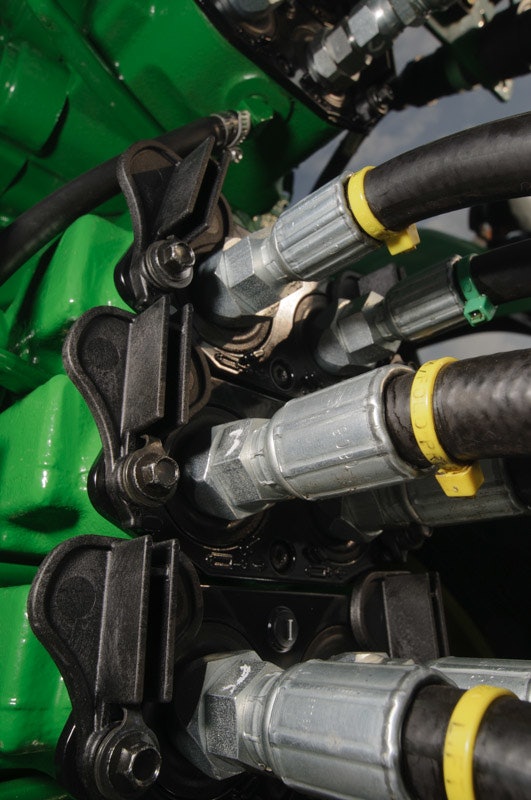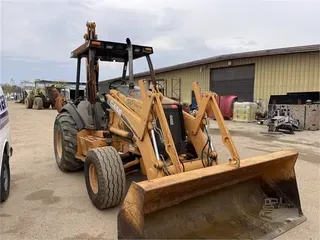Todays hydraulic systems are marvels in efficiency and performance and are called upon to power increasingly complex implements. Instead of dropping a pin, producers are hooking up hydraulic hoses that power systems that increase the demands on the hydraulic systems.
Hydraulic systems have met the demand with increased efficiency and performance and, as such, a greater emphasis is now required to ensure the system is working as it should. And that starts with maintenance.
No longer are we dropping a pin and hooking up an implement, says Brett Gutknecht, high horsepower product specialist, Case IH. We are now using hydraulic systems in the tractor to control smart implements or power precision planters. Its very important that we look at our hydraulic systems on a tractor to make sure were not only not damaging the system on the tractor, but the implement behind it.
Variable displacement pumps and tighter tolerances compared to older systems provide this performance. But it also puts added demands on the hydraulic fluids and filters. Todays systems require higher quality oil and filtration to ensure proper operation of the system while improving its longevity, adds Brian Gould, field service manager, and the team at New Holland North America. This will ensure you get not only the maximum performance and productivity out of your machine, but also the maximum life out of the wear components that make up the hydraulic system.
Keep it clean
The bottom line for any system is keeping it clean.
The goal should be to keep the system as clean as possible. That can be difficult, especially in the farming environment, Gutknecht says. What I tell customers is any time you open the hydraulic system, whether that be pulling off the cap on the top of the tank reservoir or unplugging a line from the back of the tractor, make sure you clean the surface before opening up the cap or pulling the hose. And if you are walking away for an extended amount of time, cap it to keep the dust and dirt out.
The coupling also needs to be cleaned properly to ensure additional contaminants are not introduced into the system. If I walk around a tractor and see a dust cap off and a dirty coupling, I will mention it to the operator, he says. I will often see them grab a degreaser and wipe the dust off. That helps, but it also means the next time a hose is attached the degreaser may make its way into the system. You need to ensure you are cleaning it properly.

Another common issue is the hydraulic fluids being used throughout the farm.
Not all oils are created equal and this can be detrimental to the health of the hydraulic system, Gould says. This not only applies to the oil you use to top up the system, but what oil is in the implement you are hooking up. Try to run a consistent oil in your fleet to reduce contamination. If you are getting a new unit, consider flushing the system to ensure compatibility.
The walkaround
Regular system maintenance called for in the owners manual is an imperative, but so is a daily system inspection to catch potential problems before they become major and, potentially costly, issues.
Daily inspection of fluid levels and topping off reservoir tanks sounds simple enough, but in the hustle of a busy workday that one task can get missed. Not having enough fluid in the system can lead to major issues, not only for the tractor but for the implement you are using, Gutknecht says.
Before you head out for the day, your walk-around should also include inspection of the various hydraulic systems on the tractor, he adds. Look all the way around, because all leaks may not be as visible as a pool on the ground.
Something that may be harder to catch are the small leaks coming out of a line or fitting. Over the course of a day, that small leak is probably going to collect a little bit of dust. That weep and collection of dust is a smoking gun saying that something is not right.
I will often hear producers say its just a small leak and theyll get to fixing it later, Gutknecht says. But a small leak indicates theres a problem. It could be as simple as a fitting that needs to be tightened, or it could be a seal thats ready to blow. Once that happens, it becomes a major issue.
While the manuals regular maintenance schedule is a key first step, producers also need to be mindful of their working environment. If you are operating in severe conditions, increasing the frequency of your service intervals is cheap insurance toward the prevention of a major failure.
Routine maintenance and keeping the system clean can go a long way in ensuring optimal performance and longevity. Another recommendation is to get the systems fluid tested. A routine analysis helps identify trends to catch failures occurring early on, reducing costs. It can also go a long way with potential buyers if you are selling your equipment.
And give the tractor enough time to warm up before calling on the hydraulic system.
You get want you pay for
What goes into the system is critical, with the adage you get what you pay for repeated many times.
Not all oils and filters are created equal. Although they all may perform to some extent you will not get the protection and reliability out of cheaper products than you will get from the high-end products due to different additives and different manufacturing techniques, Gou

